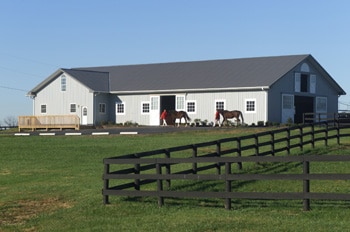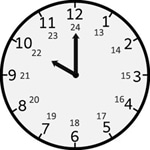Have you ever wondered about the research horses used in equine science studies? Horse Lover’s Math has had posts based on the results of research projects; Do Horses Like Music?, How Much Weight Can Horses Comfortably Carry?, Research Continues on Wild Horses of Shackelford Island and more. But what about the lives of the horses themselves? What is a typical day like in the life of a research horse?
Kentucky Equine Research is one of the places where equine research is conducted. Let’s follow along on a typical day!

1. The clock to the left shows their arrival time. What time do they arrive? Be sure to include a.m. or p.m. in all your answers.
Some of the horses in the barn are being used on a feed preference trial. They’re rations of normal sweet feed and hay are precisely measured, as are the rations for those horses enrolled in an exercise trial.
Other horses are participating in a digestion trial. For these horses, the research interns collect fecal and blood samples. This is done before the horses get the same type of breakfast as their stablemates.
Science Talk – fecal: another word for an animal’s manure.

2. What time are these horses led out of their stalls to be groomed?
The treadmill belt begins at a walking speed for a certain length of time, then moves to a trotting rate, and finally accelerates so the horse is cantering or galloping at a speed that simulates race training.
Heart rate is monitored and blood is drawn for analysis of pH, lactate level, and other metabolic markers. In some trials, horses breathe into a mask that traps exhaled air. Tests of the exhaled gases show the point at which the horses use up readily available glucose and begin to draw energy from stored fat.
You can conduct these procedures yourself when you play Do You Want to be a Horse Scientist?
Following treadmill exercise, the horses are bathed and then cooled out on a mechanical exerciser.

3. What time are the horses in digestion trials scheduled to be checked over, groomed and turned out?
Outside, the horses survey their surroundings, paying close attention to anything that may have changed overnight—blowing leaves, an odd sound from the hedge, an upside-down wheelbarrow near the barn door— and then have a good roll in the dirt, sometimes covering themselves with mud if the weather has been rainy.

4. The clock to the right shows when these jobs are performed. If you were one of the interns, what time would you bring the horses in?

5. If these horses were turned out at 8:30 a.m., how long did they spend in their field?
These Thoroughbred geldings are in their late teens or early twenties. Having spent their younger years as exercise trial horses, most have treadmill experience, but they have been “retired” to studies that don’t require strenuous exercise. In a typical digestion trial, a particular nutrient or element is tested to determine how much of the ingested substance is actually retained by the horse.
Now it is time to bring in the horses being used for the feed preference trial, the five-year-old geldings—Barney, Nash, Ollie, Izzy, Sam, Larry, Joe, and Bob.
6. What time are the horses used for the feed preference trial brought in?
In a typical study of this type, the effect of flavouring on sweet feed is being observed. Each horse is offered feed in two identical buckets, one portion with flavouring (orange, cherry, or wintergreen, for instance) and one without. The positions of the buckets are switched every other day to eliminate habitual choice. At the end of five minutes, the amount left uneaten in each bucket is measured. If one flavour is proven particularly appetizing, it might be developed as an additive to tempt picky eaters or those whose appetites are depressed because of illness, travel stress, or fatigue.
One hour after the feed preference horses are brought in all the horses are tucked in for the evening and are left munching hay.
7. What time is it when all the horses are tucked in for the evening?
Their stalls measure twelve feet by twelve feet and are bedded with pine shavings over heavy rubber mats. Stall bars and large windows provide plenty of ventilation and allow horses to keep their friends in sight.
8. Do you need to know the perimeter of the stall or the area of the stall when determining the number and placement of the rubber stall mats?
A section on stall mat size and placement is included in the Stable Management section of the Level 1 workbook, due out this spring.
A final evening visit is made, all horses are checked, and a last measure of hay is given before the lights are turned out.
9. If you were the intern responsible for the final evening visit, what time would you arrive?
Did you get any ideas for science projects you would like to do from reading this post? If you did, share them with other HLM readers by telling us about it in the comment box below.
1. The clock to the left shows their arrival time. What time do they arrive? Be sure to include a.m. or p.m. in all your answers.
Answer: 7:00 a.m.
2. What time are these horses led out of their stalls to be groomed?
Answer: 7:30 a.m.
3. What time are the horses in digestion trials to be checked over, groomed and turned out?
Answer: 8:00 a.m.
4. The clock to the right shows when these jobs are performed. If you were one of the interns, what time would you bring the horses in?
Answer: 1:00 p.m.
5. If these 8 horses were turned at at 8:30 a.m., how long did they spend out in their field?
Answer: 6 ½ hours
6. What time are the horses used for the feed preference trial brought in?
Answer: 4:00 p.m.
7. What time is it when are all the horses tucked in for the evening?
Answer: 5:00 p.m.
8. Do you need to know the perimeter of the stall or the area of the stall when determining the number and placement of the rubber stall mats?
Answer: Area
9. If you were the intern responsible for the final evening visit, what time would you arrive?
Answer: 10:00 p.m.
Common Core:
3.MD.A.1 – Tell and write time to the nearest minute and measure time intervals in minutes. Solve word problems involving addition and subtraction of time intervals in minutes
4.MD.A.2 – Elapsed time; Elapsed time: word problems
Photos:
Top 3 photos courtesy of Kentucky Equine Research
Thoroughbreds in field by Mick Lobb; CC BY-SA 2.0
Horse in stall by Teresa Klein










